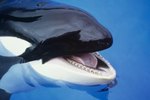
Unlike most birds who take to the sky to get around, penguins have adapted to be excellent swimmers and divers. Penguins evolved from ancestors who could fly, but adapted to diving and swimming. While they may not be able to fly through the air, they are experts at flying through the water.
Diving
Penguins are expert divers, with species like the Emperor penguin capable of plunging 1,500 feet under water. In order to accomplish this feat, their wings are structured differently from flying birds. They have short, stubby wings that act more like flippers than the wings of flying birds. Unlike most birds that swim, penguins use their modified wings to propel themselves rather than their feet. A small wingspan reduces drag when they are diving. Dense, solid bones, not hollow, allow them to dive rather than just float on the water.
Energy Efficient
While no other species of bird are capable of swimming quite like penguins, there are some birds that swim and still manage to fly. The thick-billed murre is a bird that is closely related to penguins, but is capable of flight as well as the ability to swim. It requires a lot of energy for the murre to fly, having to beat its wings much faster than other flying birds in order to take to the air. According to National Geographic, the thick-billed murre uses more energy than any other bird in order to fly. At some point during the penguin’s evolutionary history, it was more energy efficient for penguins to give up flying all together and focus their energy instead on diving and swimming to capture food.
Access to Food
Another reason penguins lost their ability to fly was to become more competitive for food under water. By being more efficient divers, penguins were able to access deeper depths than other seabirds. This gave them access to food sources other birds weren’t capable of reaching. Penguins spend as much as 75 percent of the lives in the water, coming on shore for molting and breeding. Penguins eat krill, squid or fish depending on the species, and only eat while at sea. During their time on land, penguins fast.
Too Big
Part of what prevents a penguin from being able to fly is their large bodies. Penguins’ larger bodies facilitate in diving deeper and longer. Unfortunately, their heavier bodies make them too heavy to fly. A larger body also helps keep penguins insulated in the freezing cold waters they dive into. Their unique body shape is streamlined for gliding through the water.
References
- Huffington Post Science: Penguins' Flying Ability Lost as Birds Became Better Swimmers, Study of Murres Suggests
- BBC News: Puzzy of Why Penguins Cannot Fly Solved
- National Geographic: Why Did Penguins Stop Flying? The Answer is Evolutionary
- Sea World: Penguins Adaptations For an Aquatic Environment
- Sea World: Penguins Diet and Eating Habits
Photo Credits
-
Frizi/iStock/Getty Images




